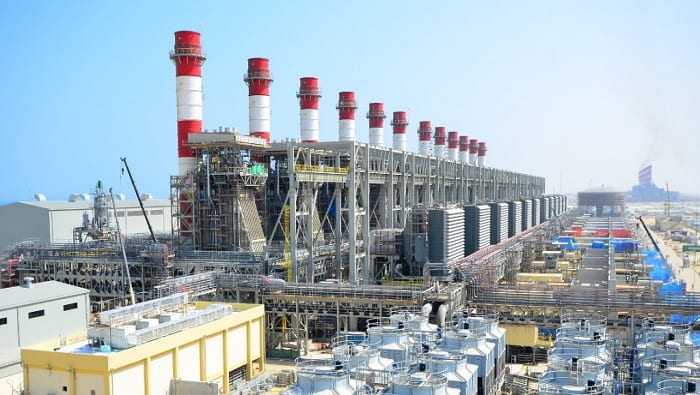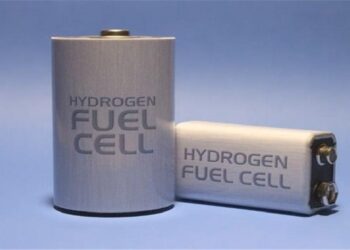The Grand River Dam Authority is currently constructing a new natural gas-fired combined-cycle unit alongside the two existing coal-fired units at the Grand River Energy Center in Chouteau, Oklahoma. Photo courtesy: GRDA
They handed out popsicles at a power plant construction site in Chouteau, Oklahoma this summer. That might sound like a funny thing to serve hundreds of burly workers who are used to laboring in heavy indutry, but Oklahoma is on the same latitude as Morocco, and summers can be brutal. Building a combined-cycle natural gas-fired power plant requires a lot of hard work.
Just ask the welders who have to crawl on their backs into the bowels of these monster machines, garbed in heavy long-sleeve clothing, in order to weld pipe in near tropical conditions. They’ll tell you that collapsing from heat stroke can kill you just as quickly as falling off the top of a heat recovery steam generator (HRSG). So the popsicles were more than a frivolity; they were an integral part of employee safety. And they tasted pretty good too.
Owned by the Grand River Dam Authority (GRDA), the Grand River Energy Center (GREC) has undergone something of an evolution in recent years. A flurry of environmental upgrades, combined with a major construction project to build a new natural gas-fired combined-cycle unit at the site, has made the facility a very busy place. The GREC began life as a two-unit coal-fired plant.
The 490-MW Unit 1 was constructed in 1978 to burn sub-bituminous coal delivered from Wyoming. A 520-MW Unit 2 followed some years later in 1985. Both units were fitted with the latest technologies to reduce emissions. Unit 1 employed an electrostatic precipitator (ESP), while Unit 2 was equipped with a flue-gas desulfurization (FGD) scrubber to reduce sulfur emissions.
But environmental regulations are a moving target. They require utilities to constantly retool their strategies in an attempt to comply with the latest mandates from the Environmental Protection Agency (EPA), not to mention the myriad of state and regional protections that demand attention. GRDA was in the midst of an effort to accomplish just such a project this summer, replacing the existing ESP on Unit 2 with a fabric filter, and adding an activated carbon injection system. That’s when lightning struck the plant during one of Oklahoma’s July thunderstorms.
The resulting fire caused significant damage, taking Unit 2 offline entirely. While Unit 1 continued to operate unaffected, Unit 2 continues to sit idle today. Plant personnel expect repairs to be complete and the unit back up and running by June 2017, coinciding with another exciting milestone at the plant: the commissioning of the GREC’s newly-constructed natural gas-fired, combined-cycle Unit 3, which among its many customers, will provide power to a Google server center about five miles down the road.
“We expect this unit to be the most efficient facility in the Southwest Power Pool,” says Charles Barney, Assistant General Manager of Fuel & Generation Projects at GRDA. Barney explains that the new plant will not only decrease GRDA’s reliance on coal, it will also minimize carbon emissions ahead of new regulations outlined in the federal government’s Clean Power Plan (CPP). While the details of the CPP are still under intense scrutiny in the courts, GRDA is not waiting around to see what parts of the proposed rule will be codified into law. “We expect this plant to exceed new EPA standards by a significant degree, producing 25 percent less carbon dioxide than the latest standards require,” Barney notes. Natural disasters notwithstanding, things are working out pretty well for the GREC.
But success was not always inevitable. Go back a few years, and GRDA had some hard decisions to make. “Like lots of utilities, we had re-permitting to consider,” says Jammie Burrow, Chief Engineer of GREC Generation Projects. “Additionally, we had to think about regulations like the Mercury and Air Toxics Standards (MATS).” In looking at its generation model, the utility came to understand that what had worked so well for it in the past, wasn’t going to work in the future. “Since our founding in 1935, GRDA has tried to provide safe, reliable, and cheap electric power,” he continues, “and we feel like we’ve been pretty successful at it.” Still, Burrow says, the utility needed to make some changes.
Historically, more than half of the generation capacity in Oklahoma has been coal-fired. The technology was well-tested, and the fuel was readily available. “GRDA relied more on coal generation than any other utility in Oklahoma,” Barney says. “Well over 70 percent of our total energy generation was coal-based, but we made a conscious decision to change that.”
Burrow expands on this: “We looked at upgrading one of our coal units, or converting one of those units to burn natural gas,” he says. “We also looked at purchasing an existing combined-cycle plant or executing power purchase agreements.” In the end, GRDA decided the best choice was to build a new combined-cycle plant from scratch. “This insured a long life for the utility,” Burrow says. Thanks to the addition of natural gas-fired and renewable assets, these days coal power comprises only about 30 to 35 percent of the utility’s generation mix.
There’s any number of reasons to minimize the use of coal in this country, and not all of them are related to air and water quality. Barney explains that with the rise of renewable power in the state, coal could no longer operate in its traditional baseload capacity. Rather, it was being asked to serve as backup power, following the wind, which can be very unpredictable. This arrangement created problems, because coal-fired plants are not particularly responsive. “They’re slow to cycle,” Barney says. GRDA had to revise its strategy, fine tuning its generation portfolio to better support both its intermittent wind resources and its hydroelectric resources, which can be seasonal due to variable rainfall in Oklahoma.
“Combined-cycle units operate more efficiently at part load,” Barney explains. “This makes them better at following renewables. When the wind is blowing, GRDA is able to take advantage of this cheaper source of renewable energy, backing down our other generators.” But when backup power is required, he continues, GRDA needs natural gas-fired facilities to be ready.
Nuts and Bolts
So GRDA called in the big guns. To complete the $472 million, 495-MW project, they contracted with Black & Veatch to serve as owner’s engineer. “We realized we’re a small utility and would need a little help to navigate our options and make the best decisions possible,” says Burrow.
In addition to Black & Veatch, TIC/Kiewit Engineering and Design was retained as the engineering, procurement, and construction (EPC) contractor. Nooter/Eriksen provided the HRSG, while Hitachi Power supplied the generator step-up unit. Enable Oklahoma Intrastate Transmission, a subsidiary of Enable Midstream Partners, provided the pipeline and natural gas supply.
Groundbreaking ceremonies were held in January 2015, and mechanical completion of the plant is expected by the end of this year. Commercial operation is planned for June 2017. In the end, about 650 workers will have labored around the clock for two years to make the plant a reality. To further complicate the project, the construction team shared space with a simultaneous campaign to finish an $86 million environmental upgrade to the air quality control systems of the coal-fired Unit 2. Logistics were king; margins of error were very small.
At the heart of the new facility is the M501J combustion turbine, built by Mitsubishi Hitachi Power Systems Americas (MHPS) at its Savannah Machinery Works in Georgia. It’s the first J-Series turbine in North America, delivered by barge up the river in February 2016.
Speaking at the press event held to honor the occasion, MHPS President and CEO David Walsh noted that the largest gas turbine in 1980 was about 100 MW, making the GREC turbine about 3.3 times larger than anything possible only a few decades ago. Walsh also said the new turbine will emit 67 percent less carbon dioxide (CO2), 96 percent less nitrogen oxides (NOx), and 99.9 percent less sulfur dioxide (SO2) than older coal-fired units.
The M501J turbine has an ISO base rating of 327 MW in simple-cycle operation, and a rated rotor speed of 3,600 RPM. Weighing in at about 320 tons, the 60-Hz machine has a ramp rate of 40 MW per minute, and a startup time of about 30 minutes. In the 1-on-1 combined-cycle configuration in which the turbine will be utilized at GREC, the turbine delivers just over 470 MW, with efficiency approaching 62 percent. The new J-Series technology fires at an inlet temperature of 2,912°F, about 100 degrees hotter than its G-Series predecessor.
Construction of Unit 3 represents the first time in 30 years GRDA has broken ground on a new power plant. “A key objective for GRDA and our project partners was to set a new standard in power generation, and to do it right here in Oklahoma,” says Barney. “We’re a relatively small organization, and it was crucial that our project partners shared our goals and strategies.”
The GREC site was originally designed for three coal-fired units.
“That means there was ample room to drop in a combined-cycle facility,” says Burrow. Water is supplied via the Grand Neosho River and is ample. Additionally, existing transmission facilities were available and sufficient to the task of delivering additional power from the new unit. Natural gas transportation also proved ideal. “Building pipeline is incredibly expensive,” Burrow says, “but just a mile and a half up the road from us there was a convergence of two existing gas lines. That means we only had to build a short section of pipeline to tie into the supply.”
Permitting for the plant was also easier than it would have been for an entirely new facility, because Unit 3 is built adjacent to the existing coal-fired infrastructure, so the site is not greenfield. “We did have to build a new substation to support the combined-cycle addition,” Burrow continues, “but overall we’ve had a lot of advantages and enjoyed the benefits of a nice hub.”
“We’re the poster boy for the EPA,” Barney says speaking about the GREC. “I don’t mean that the least bit sarcastically. If the EPA were to look at our strategy, they would see a utility that is doing what they desire utilities to do-reducing emissions of carbon and other pollutants.”
Nevertheless, Barney says much of the impetus behind GRDA’s decision to build the new plant was not simply to comply with environmental mandates issued by the EPA, but to insure the reliability of operations that the utility’s customers have come to depend on. “We’ve built this new unit to be utility-grade,” he says. “It’s more robust in its design than many plants built to merchant specifications.”
For example, he explains, a merchant plant might have a single pump to perform a given duty. When that pump goes down, the whole plant goes. The GREC, in contrast, has backup systems built into its operations. If a pump fails, there’s another pump to carry on operations while the damaged machinery is repaired. It’s this redundancy that allows for the rock-solid performance the utility has targeted, Barney says.
“We aren’t just trying to make as much money as we can with as little investment as possible,” he continues. “We are trying to serve our customers as reliably as we know how.” And the GRDA does have some large customers. Barney again mentions the Google server center, explaining that it is connected to the GREC plant via redundant transmission lines, insuring rock solid dependability. “You can’t rely on 40-year old equipment to do that,” Barney says.





































